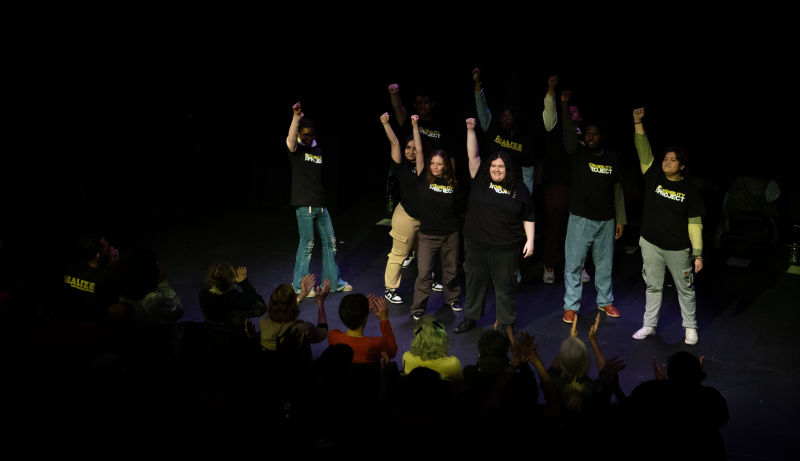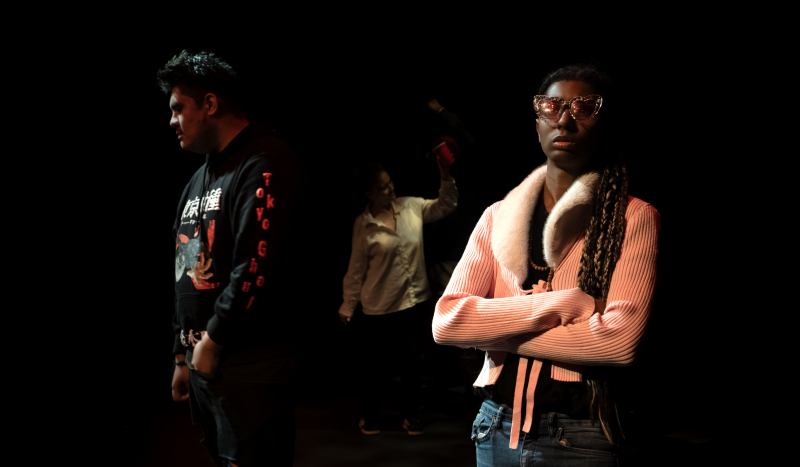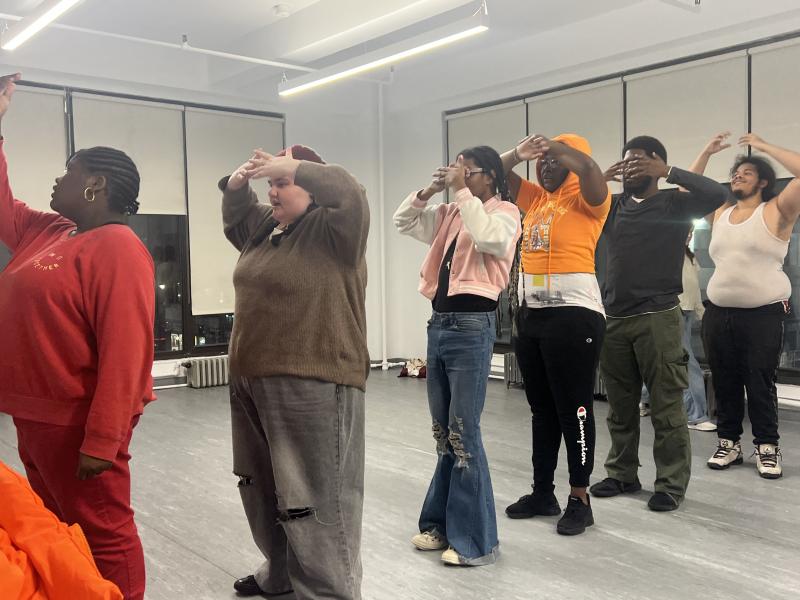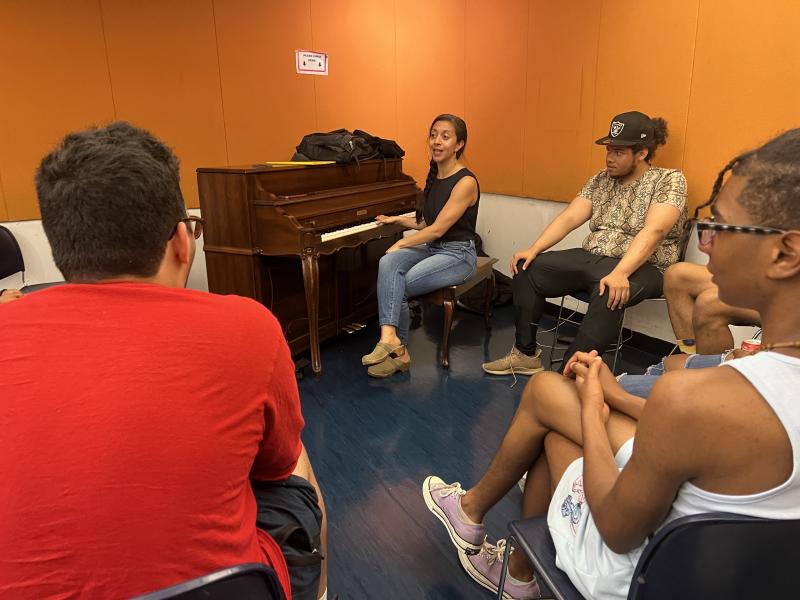Grant Spotlight: The Possibility Project

The Possibility Project’s 2023 Foster Care Performing Arts Program cast rehearsing the middle number of their original musical “REALIZE.” Photo courtesy of Paul Griffin
Established in 2001 by Founder and President Paul G. Griffin and a dedicated network of New York City youth, parents, educators, artists, and community organizers, The Possibility Project emerged in response to the diminishing opportunities for youth to engage in artistic expression, bridge cultural divides, and make their voices heard. Christina Calfo, director of development at The Possibility Project, said, “We began operations with a single general-interest Saturday Program involving 24 youth, which grew to more than 70 teenagers by 2005.” Currently, The Possibility Project offers in-person and virtual programs that serve over 100 New York City youth.
Last month, The Possibility Project received an Arts Endowment grant to support the work of a new musical theater production that will be written and performed by a cast of 25 foster care youth. As the organization approaches its 50th program completion this spring, Calfo reflected on the impact of NEA funding throughout the years and said, “The NEA’s continued support of the Foster Care Performing Arts Program has played a vital role in allowing us to offer a much-needed space for youth in foster care to interact with one another, share common experiences within the foster care system, and learn to trust both peers and caring adults.”
Calfo spoke with us about the Foster Care Performing Arts Program’s upcoming musical theater production and the role of the arts in empowering and positively transforming youth to creatively and impactfully tell their stories.
NEA: What sparked the creation of the Foster Care Performing Arts Program?
CHRISTINA CALFO: The Possibility Project’s Foster Care Performing Arts Program was launched in 2009, following eight years of general-interest programming available to all NYC [New York City] youth. The Foster Care Performing Arts Program began in recognition that the myriad social issues and threats facing all young people—poverty, an overburdened and dysfunctional public education system, racism, sexual harassment, heterosexism, and violence to name a few—were exacerbated for youth in the child welfare system. On top of these challenges, these young people had to navigate the social stigmas of being in foster care, a transitory living situation, and a high risk of abuse and neglect, often following traumatic experiences that led them to be placed in foster care.
The Possibility Project's Foster Care Performing Arts Program has used the performing arts to improve the lives of NYC youth in foster care, while producing 14 unique theatrical productions expressing their experiences within the child welfare system. Our aim is to bring a rare, vibrant, and much-needed artistic voice to the foster care community at large, including those young people who have recently aged out, and shine a spotlight on the under-recognized needs and aspirations of youth in foster care. This program is, to our knowledge, the only ongoing performing arts program for youth in foster care in NYC.
NEA: Could you share more about what The Possibility Project does?
CALFO: Led by the young people themselves working in collaboration with professional artists, The Possibility Project’s programs all follow a nine-month model that integrates social change-centered workshops with training in music, dance, acting, voice, improvisation, playwriting, and theater. This dual-approach, social justice-centered model allows participants to build important, durable relationships, resolve conflicts without violence, analyze oppression, address traumas, engage in positive community action, and develop real-world leadership skills. To achieve this impact, each program’s youth are challenged with two tasks during their time together at The Possibility Project: to write, rehearse, and perform an original musical theater production that expresses the reality of their lives and their vision for change focused on the most serious issues they face; and to design and execute community action projects that make a tangible impact on issues they identify as most pressing in NYC.
The Possibility Project currently operates four performing arts programs—our Saturday Program, made up of 60 youth from diverse backgrounds (ages 13-19), our Foster Care Performing Arts Program for up to 25 youth in foster care (ages 15-21), our Youth Justice Program for up to 15 youth involved in the justice system (ages 16-24), and our Virtual Program for up to 20 youth from diverse backgrounds (ages 13- 19).

The Possibility Project Foster Care Performing Arts Program cast onstage in their original musical “REALIZE,” December 14-17, 2023. Photo courtesy of Ahmed Hassan
NEA: Part of The Possibility Project’s mission statement is to “empower diverse casts of teenagers to transform the negative forces in their lives and communities into positive action.” How does theater serve as powerful tool in uplifting youth?
CALFO: Theater is at its most vital and compelling when it brings new voices and visions to the stage—discovering and telling untold stories—weaving the actors, sets, lights, and sounds into a powerful, beautiful, meaningful experience; bringing communities together to experience new ideas and feelings; examining who we are and how and why we live; expressing our deepest conflicts and fears; illuminating our shared humanity; and creating a vision for how we can live together here and now. This is what The Possibility Project does in every program, every year. By engaging with the arts in this way, The Possibility Project’s participants examine the root causes of oppression in their lives and communities, its traumatic effects on their well-being and growth, and the intersection of these individual and social forces. Our social oppression workshops allow for youth in foster care to share their experiences with racism, sexism, heterosexism, and adultism, and discuss the harm these forces have engendered. These trainings and discussions are coupled with performing arts trainings and group scene-work and arts activities: youth work together across differences to create scenes illuminating the characters, events, and effects of their experiences, and begin to imagine resolutions to the conflicts they have navigated in theatrical form. The work created through this process is then shaped by the youth-led production team into an original musical, through which youth gain the skills, support, and courage to share their collective story and vision for change with NYC audiences. All of these activities are directed toward empowering our young people and transforming the painful experiences they have faced into positive, generative action for the future ahead of them.
The creative space that theater provides gives our youth the opportunity to process their traumatic and complex experiences and to understand others’ experiences, as well. Much of this interpersonal exploration with peers, as with the arts training they receive, is happening for these young people for the first time. Their group exploration changes their feelings of isolation into something more proactive and communal; the extreme isolation of the pandemic and now the return to “normal” life has made this process an even more important tool in our communities.
NEA: What are some of the main challenges that The Possibility Project faces in its work with foster care youth, and how does the organization address these challenges?
CALFO: One of the most important challenges we face with our youth in foster care is building trust in the rehearsal room. Understandably, our youth in foster care have learned through hard experience to be wary of adults. They have also learned to be wary of one another. We work very hard, and very patiently, to earn our youth’s trust by always showing up for them, always listening, and always taking them seriously. The creative process offers a multitude of opportunities for this trust to examined and built. The greatest external challenge we have faced recently in the years immediately following the pandemic has been the return from COVID-necessitated virtual programming to in-person programming. While it’s been incredible to be back live with our young people, connecting and creating in person again, the pandemic’s effect both on our youth and in the community at large is certainly still felt. Many of our community connections in foster care agencies and residential centers were lost or weakened during the pandemic, and those agencies have been stretched to capacity and often do not have the staff required to enable our foster care youth to engage in program activities. While the push towards pre-pandemic operations may be more slow-going than anticipated, we are actively working throughout the year to develop or deepen community relationships, and are working every week with our foster care youth in rehearsals to strengthen a sense of community, accountability, and commitment to one another and to the goals of justice and peace towards which we are working.
NEA: Can you provide us with an overview of what the upcoming musical theater production entails?
CALFO: The Foster Care Performing Arts Program will begin its recruitment in March of 2024 through non-competitive group auditions arranged in partnership with over ten foster care agencies and centers across NYC. No participant is ever chosen on the basis of talent or arts experience, but on their need for the program and the benefit of the training offered, as well as the willingness to engage with other youth in foster care on the issues they care about. Because no one is chosen based on talent, we reach young people who are often excluded from traditional arts programs. For many of our youth in foster care, we will be their first hands-on exposure to the arts.
Selected participants will begin rehearsing bi-weekly after school in April 2024. For the first three months, participants will be led through social change trainings, community building, and trainings in the performing arts disciplines—acting, improvisation, dance, voice, singing, and playwriting—as well as sharing their lives with one another including in artistic form. From the skills, written and performed content, and themes that emerge in these first three months, participants will then work together to create, write, and perform a full-length original musical about their lives and ideas for change, with the help of the youth production team (the leadership team of youth responsible for the program’s guidance) and The Possibility Project artistic staff. The cast will premiere their show in an Off-Broadway theater in November 2024. Participants will then design and execute a community action project that tackles one or more sociocultural issues in the general public, taking place January 2025.

The Possibility Project’s 2023 Foster Care Performing Arts Program cast rehearsing the middle number of their original musical “REALIZE.” Photo courtesy of Paul Griffin
NEA: What do you hope audience members walk away with after attending the musical theater production?
CALFO: Participants are challenged, from their first rehearsal with us, with the goal of writing and performing a show from their own experiences and the hope is to change the hearts and minds of audiences. This is particularly true for our foster care casts, as roughly half of all audiences to their musical will be other youth in foster care and the agency staff and administration accompanying them. By honestly sharing the difficult realities facing foster care youth, our participants are offered a unique opportunity to voice their experiences and visions on how these systems might change to adults responsible for creating or enforcing them. Other youth in foster care who come to witness the cast’s work are also given the rare opportunity to see the issues they face represented on a New York professional stage, told by their peers who have themselves lived through these experiences. Our hope is that both groups see and hear our youth, understand the value of centering youth in the system, and walk away with a renewed sense of purpose around making life better for youth in foster care.
NEA: Could you briefly share a success story from a foster care youth who participated in the Foster Care Performing Arts Program and experienced positive transformation in their lives?
CALFO: We see the program’s positive transformations and effects on our participants every week in rehearsals. A particularly powerful example of these positive outcomes can be seen in Aaron’s story (name changed for confidentiality). Aaron is a non-binary youth in foster care, who lived in a residential treatment center when they joined The Possibility Project. When Aaron began the Foster Care Performing Arts Program, they were in a dark and lonely place: they were mistrustful of everyone and everything, fearful of any interaction, and angry at their situation, often lashing out at any perceived offense. They would speak only in one-word responses at the start of the rehearsal process and initially refused to participate in any group activities. With the consistent support of their fellow cast members and staff and the persistent encouragement to participate, Aaron began to share their life experiences and open up to their peers. After performing on stage with their cast and implementing a community action project to bring awareness to the issues that youth in foster care face, Aaron has become a full, powerful, empowered version of themselves. After a year in the program, Aaron moved into state-funded permanent housing from their residential treatment center, participated in Pride Weekend for the first time this summer, and is actively looking forward to finishing high school and going on to college.
This story is representative of the impact of our Foster Care Performing Arts Program on many youth that we have observed through extensive evaluations. In 2013, The Possibility Project partnered with Dr. Michael Hanson and the National Center for Children and Families to study the longitudinal effects of our Foster Care Performing Arts Program on participants. The report found that our Foster Care Performing Arts Program alumni are significantly less likely to be parents as young adults, or to be arrested or convicted of a crime; they are significantly more likely to be involved in civic engagement activities; and the majority of them are using the self-regulation and conflict resolution skills, learned in the program, in their lives now. They also make huge gains in communication and performing arts skills.

Musical Director Jenny Luna (center) guides the Foster Care Performing Arts Program cast through a rehearsal vocal warm-up. Photo courtesy of Paul Griffin
NEA: What do you wish you could do more of as an organization?
CALFO: We hope in the coming years to be able to provide many more of NYC’s young people, especially youth in foster care for whom our program is so impactful, with the opportunities provided in our performing arts programs. We are interested in working with populations of youth who would benefit from the creative process and whose stories would bring a new voice to NYC stages. Because of the current capacity of the organization and resources available to grow that capacity, there are limits to our ability to provide further offerings at the moment. In a world where resources were no object, we would be able to provide our programs to hundreds, if not thousands, of NYC’s young people.
NEA: Finish this sentence: Unlocking the keys to possibility in the arts…
CALFO: opens doors for a more just and peaceful future; one that far too many young people are told is unattainable.




